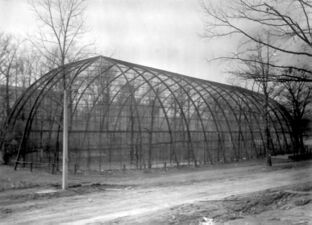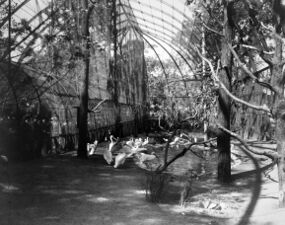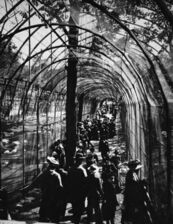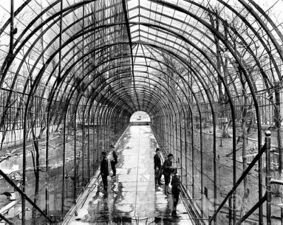Flight Cage: Difference between revisions
No edit summary |
No edit summary |
||
| (5 intermediate revisions by the same user not shown) | |||
| Line 1: | Line 1: | ||
{{ | {{SHORTDESC:Flight Cage}} | ||
{{Infobox | {{Infobox FairBuilding | ||
| name = Flight Cage | | name = Flight Cage | ||
| image = Flight Cage.jpg | | image = Flight Cage.jpg | ||
| image_size = | | image_alt = | ||
| image_size = 400px | |||
| caption = Flight Cage | | caption = Flight Cage | ||
| alternate_name = | | alternate_name = | ||
| | | location = [[Plateau of States]] | ||
| | | no_buildings = | ||
| | | construction_cost= $17,500 (${{Format price|{{Inflation|US|17,500|1904}}}} in {{Inflation/year|US}}) | ||
| furnishing_cost = | |||
| | |||
| profit = | | profit = | ||
| owner = | | owner = | ||
| | | architect = Frank Baker, Superintendent of the National Zoo | ||
| | | dimensions = 228' x 84' | ||
| | | adult_entry = Free | ||
| child_entry = Free | |||
| opening_day = | |||
| dedication_day = | |||
| special_day = | |||
| other = | | other = | ||
}} | }} | ||
The giant bird cage on the [[Plateau of States]] | |||
The giant bird cage on the [[Plateau of States]] is a fifty foot tall steel truss framework used to showcase many species of birds. After the fair, it formed the basis of the St. Louis Zoo. | |||
==Description== | ==Description== | ||
The massive structure was divided into two sections | The massive structure was divided into two sections, with a mesh tunnel 16 feet wide through the center length of the cage. | ||
The first area held large birds and fowl, cranes, storks, pelicans, hawks, swans, pheasants, etc., and the other contained small birds of song and brilliant plumage. With over 1,000 birds, almost every feathered inhabitant known to America was on display and in flight within the cage. | |||
==After the Fair== | |||
A public outcry saved relocation of the aviary to the National Zoo in Washington, D.C., and in 1905 the city of St. Louis purchased it for $3,500 (${{Format price|{{Inflation|US|3,500|1904}}}} in {{Inflation/year|US}}) (that did not include any birds). | |||
A public outcry saved relocation of the aviary to the National Zoo in Washington, D.C., and in 1905 the city of St. Louis purchased it for $3,500 ({{Inflation|US|3,500|1904| | |||
The popularity of the bird cage during the World's Fair inspired civic leaders to build a real zoological garden in St. Louis. In November 1910, the Zoological Society of St. Louis was established. The founders formed the organization with the hope that a zoo would make the city more appealing for visitors and residents alike. The St. Louis Zoo, was the first municipally supported zoo in the world. | The popularity of the bird cage during the World's Fair inspired civic leaders to build a real zoological garden in St. Louis. In November 1910, the Zoological Society of St. Louis was established. The founders formed the organization with the hope that a zoo would make the city more appealing for visitors and residents alike. The St. Louis Zoo, was the first municipally supported zoo in the world. | ||
| Line 35: | Line 39: | ||
The flight cage now hosts over 20 species of birds and is open year-round. The structure was restored in 1967 and 1996, and the interior was revamped in 2010, modeled after the swamps commonly found in Missouri and Illinois. | The flight cage now hosts over 20 species of birds and is open year-round. The structure was restored in 1967 and 1996, and the interior was revamped in 2010, modeled after the swamps commonly found in Missouri and Illinois. | ||
==Gallery== | |||
<gallery | class="center" | mode=packed-hover | widths=150px heights=150px>> | |||
File:Cage - Exterior.jpg | Exterior | |||
File:Cage - Exterior 2.jpg | Exterior | |||
File:Cage - Interior.jpg | Interior | |||
File:Cage - Interior 2.jpg | Interior | |||
File:Cage - Interior 3.jpg | Interior | |||
File:Cage - Walkway.jpg | Walkway | |||
File:Cage - Walkway 2.jpg | Walkway | |||
</gallery> | |||
==See also== | ==See also== | ||
| Line 41: | Line 56: | ||
==References== | ==References== | ||
<references/> | |||
==External links== | ==External links== | ||
[https://www.stlzoo.org/visit/thingstoseeanddo/historichill/1904flightcage The flight cage at the St. Louis Zoo] | |||
[[Category:Plateau of States]] | |||
[[Category: | |||
Latest revision as of 00:30, 5 December 2022
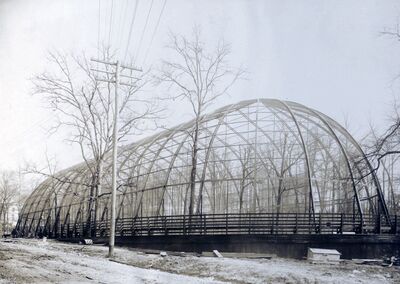 | |
| Location | Plateau of States |
|---|---|
| Construction | |
| Construction Cost | $17,500 ($527,787 in 2021) |
| Entry | |
| Adult Entry | Free |
| Child Entry | Free |
| Architecture | |
| Architect | Frank Baker, Superintendent of the National Zoo |
| Dimensions | 228' x 84' |
The giant bird cage on the Plateau of States is a fifty foot tall steel truss framework used to showcase many species of birds. After the fair, it formed the basis of the St. Louis Zoo.
Description[edit | edit source]
The massive structure was divided into two sections, with a mesh tunnel 16 feet wide through the center length of the cage. The first area held large birds and fowl, cranes, storks, pelicans, hawks, swans, pheasants, etc., and the other contained small birds of song and brilliant plumage. With over 1,000 birds, almost every feathered inhabitant known to America was on display and in flight within the cage.
After the Fair[edit | edit source]
A public outcry saved relocation of the aviary to the National Zoo in Washington, D.C., and in 1905 the city of St. Louis purchased it for $3,500 ($105,557 in 2021) (that did not include any birds).
The popularity of the bird cage during the World's Fair inspired civic leaders to build a real zoological garden in St. Louis. In November 1910, the Zoological Society of St. Louis was established. The founders formed the organization with the hope that a zoo would make the city more appealing for visitors and residents alike. The St. Louis Zoo, was the first municipally supported zoo in the world.
The city also paid $7.50 for a pair of Mandarin ducks and $20 for four Canada geese. A few local residents donated owls to add to the new collection.
In 1967, the interior of the flight cage was remodeled to include a boardwalk; in 1996, the St. Louis Zoo restored the super-structure of the birdcage.
The flight cage now hosts over 20 species of birds and is open year-round. The structure was restored in 1967 and 1996, and the interior was revamped in 2010, modeled after the swamps commonly found in Missouri and Illinois.
Gallery[edit | edit source]
-
Exterior
-
Exterior
-
Interior
-
Interior
-
Interior
-
Walkway
-
Walkway
